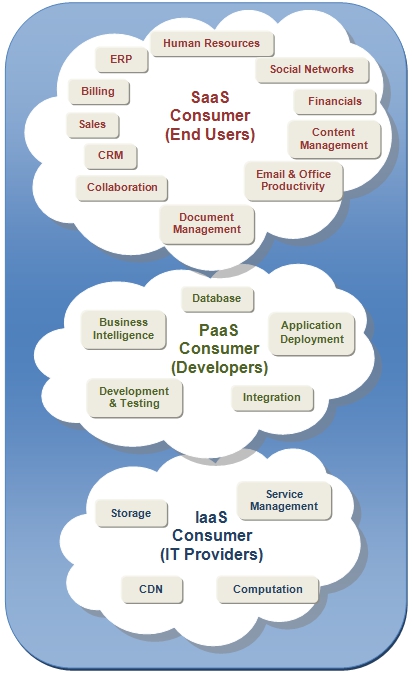
- |
- |
Basics of Cloud Computing
In simple language, cloud computing is the delivery of computing resources (hardware and software) by a party (the service provider) over the Internet to a user (consumer). This delivery or provision is described as a “service” because the user merely uses the computing resources rather than actually acquiring them. It provides shared computing resources to achieve economies of scale similar to a public utility (like the electricity grid).
With cloud computing, users can in effect “rent” computing resources (application software, hardware platforms, storage, etc.) without the need to acquire (and install) the respective hardware or software items. The cloud service provider manages the infrastructure and platforms on which the applications run, as well as security. All the user must do is access the computer resources via the Internet from the user’s device. It allows the cloud service user to get its applications up and running faster and to adjust resources more rapidly to meet fluctuating and unpredictable business demand.
Cloud computing offers many potential benefits to small and medium enterprise (SME) users, but may incur potential risks as well. Successful business has always been an exercise of balancing risk and reward — and cloud computing is no different. As a variation of IT outsourcing, it should not be surprising that many of the risks of cloud computing are the same or similar to the risks in more traditional IT outsourcing. And many of these risks can be mitigated the same way:
- appropriate due diligence up front;
- strong contractual protections that account for higher risk data and applications;
- appropriate service level monitoring by the service provider and the user;
- consider the exit arrangements (ease, speed and cost); and
- build up service governance strategies.
Service Models

There are typically three types of cloud services:
- Software as a Service (SaaS) - provides end-user applications running on a cloud infrastructure that can be accessible from various client devices. Examples of such applications include accounting, collaboration, customer relationship management (CRM), enterprise resource planning (ERP), invoicing, human resource management (HRM), content management (CM) and service desk management services, etc.
- Platform as a Service (PaaS) - provides facilities for application design / development, testing, deployment and hosting as well as platform services for team collaboration, web service integration and marshalling, database integration and developer community facilitation, etc.
- Infrastructure as a Service (IaaS) - provides processing, storage, networks, and other fundamental computing resources where the consumers are able to deploy and run their own software. Examples of such services include storage, computation, content delivery network (CDN), service management and etc.
With cloud services, users can rent application software, hardware platforms or storage, etc. without the need to acquire the respective hardware or software items. The cloud service providers manage the infrastructure and platforms on which the applications run. It allows enterprises to get their applications up and running faster and to adjust resources more rapidly to meet fluctuating and unpredictable business demand.
Deployment Models
- Public Cloud - The cloud infrastructure is provisioned for open use by the general public. It may be owned, managed, and operated by a business, academic, or government organisation, or some combination of them. It exists on the premises of the cloud service provider.
- Private Cloud - The cloud infrastructure is provisioned for exclusive use by a single organisation comprising multiple customers (e.g., business units). It may be owned, managed, and operated by the organisation (an in-house Private Cloud), a third party (an outsourced Private Cloud), or some combination of them, and it may exist on or off premises.
- Community Cloud - The cloud infrastructure is provisioned for exclusive use by a specific community of customers from organisations that have shared concerns (e.g., mission, security requirements, policy, and compliance considerations). It may be owned, managed, and operated by one or more organisations in the community, a third party, or some combination of them, and it may exist on or off premises.
- Hybrid Cloud - The cloud infrastructure is a composition of two or more distinct cloud infrastructures (private, community, or public) that remain unique entities, but are bound together by standardised or proprietary technology that enables data and application portability (e.g., cloud bursting for load balancing between clouds).
A comparison table for the four deployment models is given below.
| Aspects | Public Cloud | Private Cloud | Community Cloud | Hybrid Cloud |
|---|---|---|---|---|
| Service Delivery | Delivered over the Internet | Delivered via a private (virtual) network | Delivered via a private (virtual) network | Combination of Internet and private networks |
| Provisioning Model | Provisioned for open use by general public | Provisioned for exclusive use by a single organisation | Shared use by a specific community of organisations | Combination of two or more distinct cloud infrastructures |
| Costing / mode of payment | Utility pricing(“pay-per-use”), no upfront capital costs | Capital investments required for initial setup | Cost contributed by individual organisations | Mix of private and public cloud pricing |
| Service Level Agreement(SLA) | SLA defined by service provider | SLA defined by the organisation | Shared SLA by participating organisations | Mix of different SLA’s |
| Possible Use | Handling open / non-sensitive data with large variations in demands | Mission critical systems / handling sensitive data | Community of organisations with shared business needs | Mixed business needs |
Importance of Cloud Standards
One important enabler of cloud computing is the interoperability across its component technologies. It enables diverse systems and organisations in a cloud environment to work together, helps to lower the cost of implementation and raises the efficiency of operation. With continual expansion of different cloud services, interoperability can only be achieved through adherence to a set of open standards and agreed principles. During the foreseeable future, work to establish and conform to open standards is expected to be of major concern for both the development of different cloud components and delivery of cloud services.
The Government of the Hong Kong Special Administrative Region of the People's Republic of China






 Share
Share 









